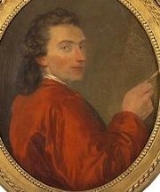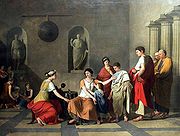
Joseph-Benoît Suvée
Encyclopedia
Joseph-Benoît Suvée was a Flemish
painter strongly influenced by French neo-classicism.
He was born in Bruges
. Initially a pupil of Matthias de Visch
, he came to France aged 19 and became a pupil of Jean-Jacques Bachelier
. In 1771, he won the Prix de Rome
. In Rome from 1772 to 1778, he prolonged the usual duration allowed to pensionaries of the French Academy in Rome
. He was named an academician on his return to Paris and he opened an art school for young women at the Louvre
. He emulated and competed with Jacques-Louis David
, earning his enduring hatred.
Named the French Academy in Rome's director in 1792, replacing François-Guillaume Ménageot
, he was imprisoned for a while in the Prison Saint-Lazare
and only able to take up the post in 1801. After a brilliant career, and a six years' stay in Rome as the Academy's Director, he died there suddenly.
His works include Achilles depositing the body of Hector at the feet of the body of Patroclus, (1769, Louvre), and Cornelia, mother of the Gracchi, (1795, Louvre).

Flemish
Flemish can refer to anything related to Flanders, and may refer directly to the following articles:*Flemish, an informal, though linguistically incorrect, name of any kind of the Dutch language as spoken in Belgium....
painter strongly influenced by French neo-classicism.
He was born in Bruges
Bruges
Bruges is the capital and largest city of the province of West Flanders in the Flemish Region of Belgium. It is located in the northwest of the country....
. Initially a pupil of Matthias de Visch
Matthias de Visch
Matthias de Visch was a Flemish painter from Bruges.To continue his artistic training, he travelled to Paris and Italy, returning in 1732. Inspired to take up a teaching vocation, he gave art lessons at his home from 1735 and reopened the Bruges art academy in 1739, acting as its director from...
, he came to France aged 19 and became a pupil of Jean-Jacques Bachelier
Jean-Jacques Bachelier
Jean-Jacques Bachelier was a French painter and director of the porcelain factory at Sèvres.Admitted to the Académie Royale de Peinture et de Sculpture in 1752, he founded an art school using his own means in Paris in 1765 for the artisans in the historic collège d'Autun , which survived until the...
. In 1771, he won the Prix de Rome
Prix de Rome
The Prix de Rome was a scholarship for arts students, principally of painting, sculpture, and architecture. It was created, initially for painters and sculptors, in 1663 in France during the reign of Louis XIV. It was an annual bursary for promising artists having proved their talents by...
. In Rome from 1772 to 1778, he prolonged the usual duration allowed to pensionaries of the French Academy in Rome
French Academy in Rome
The French Academy in Rome is an Academy located in the Villa Medici, within the Villa Borghese, on the Pincio in Rome, Italy.-History:...
. He was named an academician on his return to Paris and he opened an art school for young women at the Louvre
Louvre
The Musée du Louvre – in English, the Louvre Museum or simply the Louvre – is one of the world's largest museums, the most visited art museum in the world and a historic monument. A central landmark of Paris, it is located on the Right Bank of the Seine in the 1st arrondissement...
. He emulated and competed with Jacques-Louis David
Jacques-Louis David
Jacques-Louis David was an influential French painter in the Neoclassical style, considered to be the preeminent painter of the era...
, earning his enduring hatred.
Named the French Academy in Rome's director in 1792, replacing François-Guillaume Ménageot
François-Guillaume Ménageot
François-Guillaume Ménageot was a French painter of religious and French historical scenes. A pupil of François Boucher , he went on to win the Grand Prix de Rome and become a director of the French Academy in Rome, an academician and a member of the Institute.-Life:He was born in London, the son...
, he was imprisoned for a while in the Prison Saint-Lazare
Prison Saint-Lazare
The Prison Saint-Lazare was a prison in the Xe arrondissement of Paris, France.-History:Originally a leper hospital founded on the road from Paris to Saint-Denis at the boundary of the marshy area of former Seine river bank in the 12th century, it was ceded on 7 January 1632 to Vincent de Paul and...
and only able to take up the post in 1801. After a brilliant career, and a six years' stay in Rome as the Academy's Director, he died there suddenly.
His works include Achilles depositing the body of Hector at the feet of the body of Patroclus, (1769, Louvre), and Cornelia, mother of the Gracchi, (1795, Louvre).
External links


